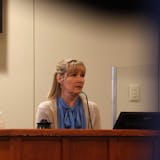Joe Delgado, chief financial officer of Preceptis Medical, had a personal reason for leaving a good job at UnitedHealth Group a few years ago.
His daughter, Vivian, now 5 years old, benefited from a tube implanted in her ears using a Preceptis Hummingbird device. The procedure was done in a doctor's office. No hospital operating room or anesthesia was needed. That made it far less costly than the standard procedure, which can run up to $5,000, and less worrying. Vivian previously had a set of tubes inserted in the traditional manner.
"I'll never forget the moment we handed our 9-month-old baby to the nurse to be put under general anesthesia," Delgado said. "It was very traumatic for me and my wife. After her tubes fell out in four months, my wife and I both wanted an alternative.
"With Preceptis, the experience was dramatically different. She recovered immediately and was smiling within a minute of the procedure being completed. That's why I'm so passionate about what we're doing."
There are more than 1 million pediatric ear-tube procedures in the U.S. performed annually by ear, nose and throat (ENT) doctors, mostly in operating rooms.
But after a decade of development, including $26 million in investor capital, Preceptis is gaining traction with the device that simplifies such procedures.
A 250-child study of its procedure in 2018 and 2019 was covered in the Laryngoscope, an ENT peer-reviewed journal. The Food and Drug Administration gave clearance and the American Academy of Otolaryngology endorsed the device for in-office procedures.
"We have received orders from Health Partners, St. Cloud ENT and the Mayo Clinic," said Steve Anderson, chief executive of Preceptis. "That being said, ear-tube procedures are down 80 to 90% this year due to COVID-19. But ENT doctors, pediatricians and Preceptis expect tube procedures to start coming back in the second quarter and return to more normal in 2022."



